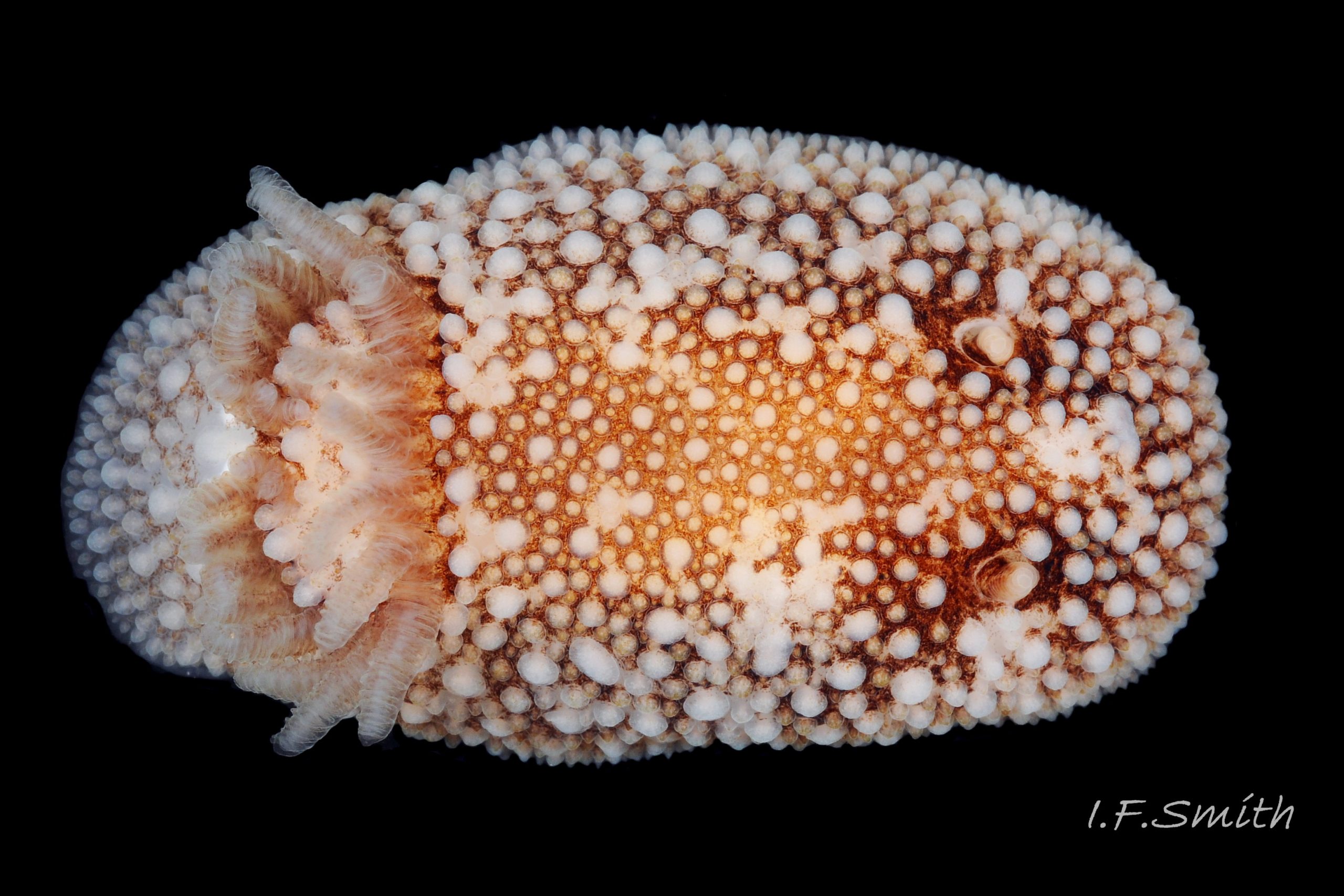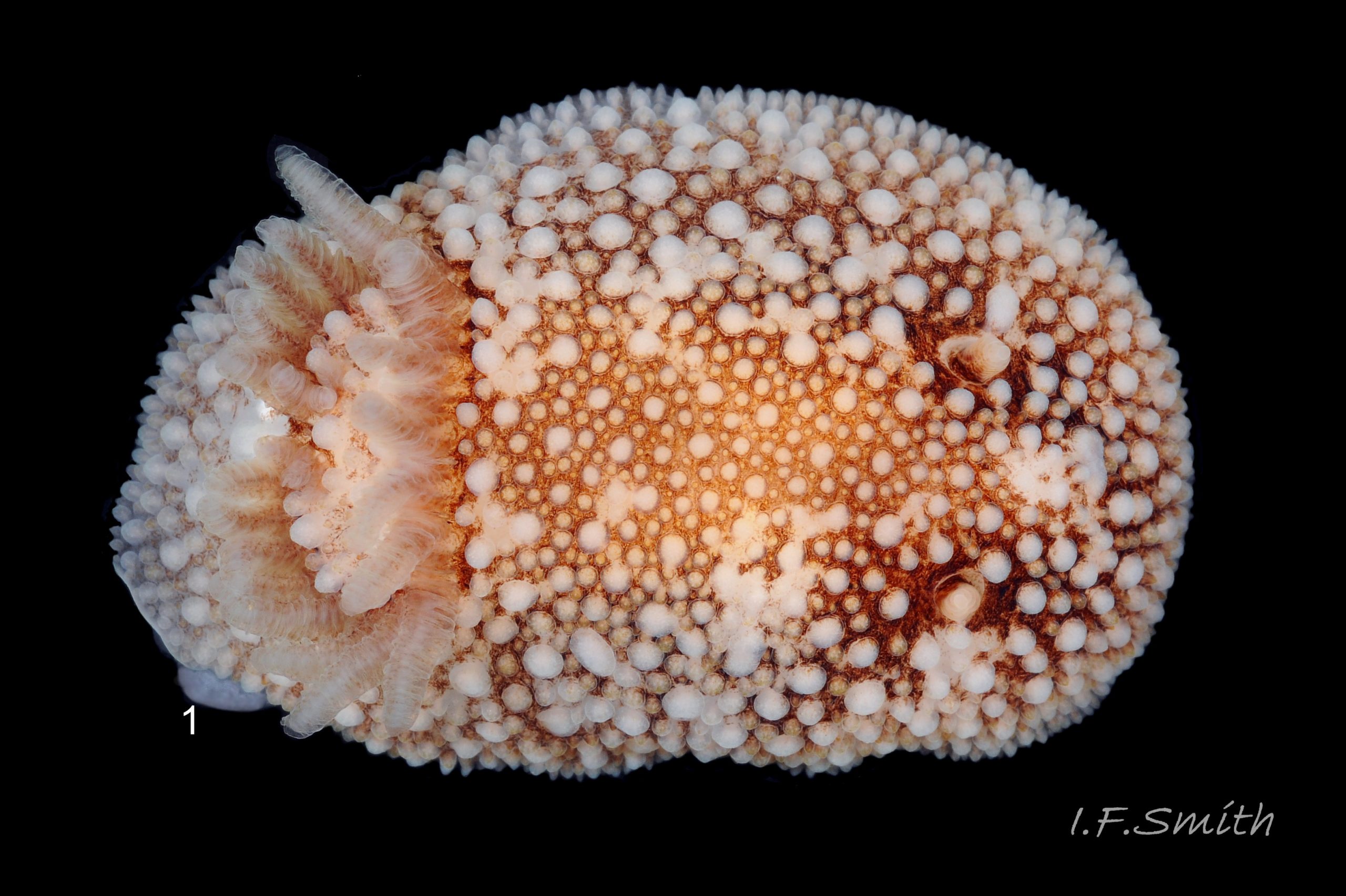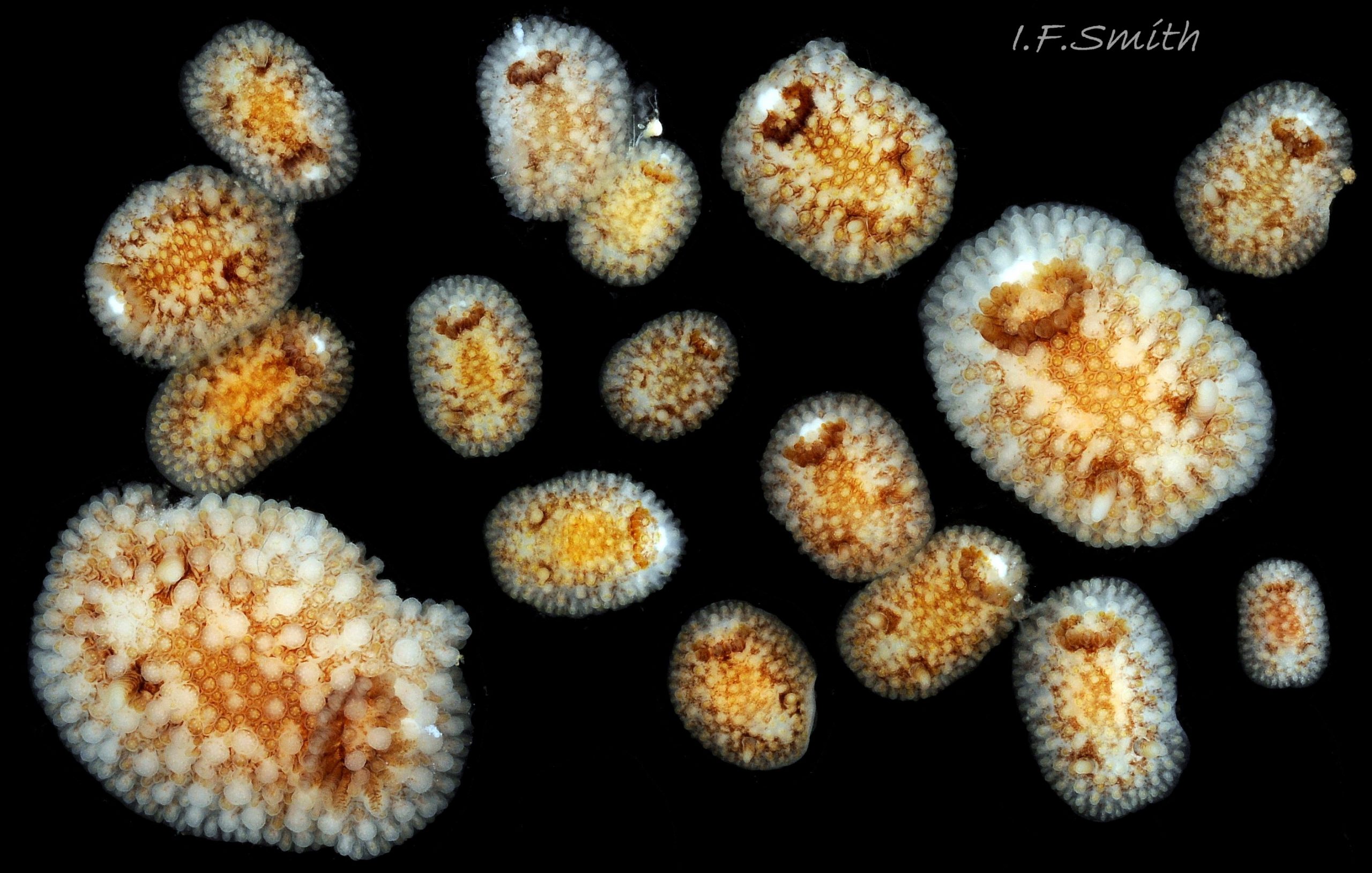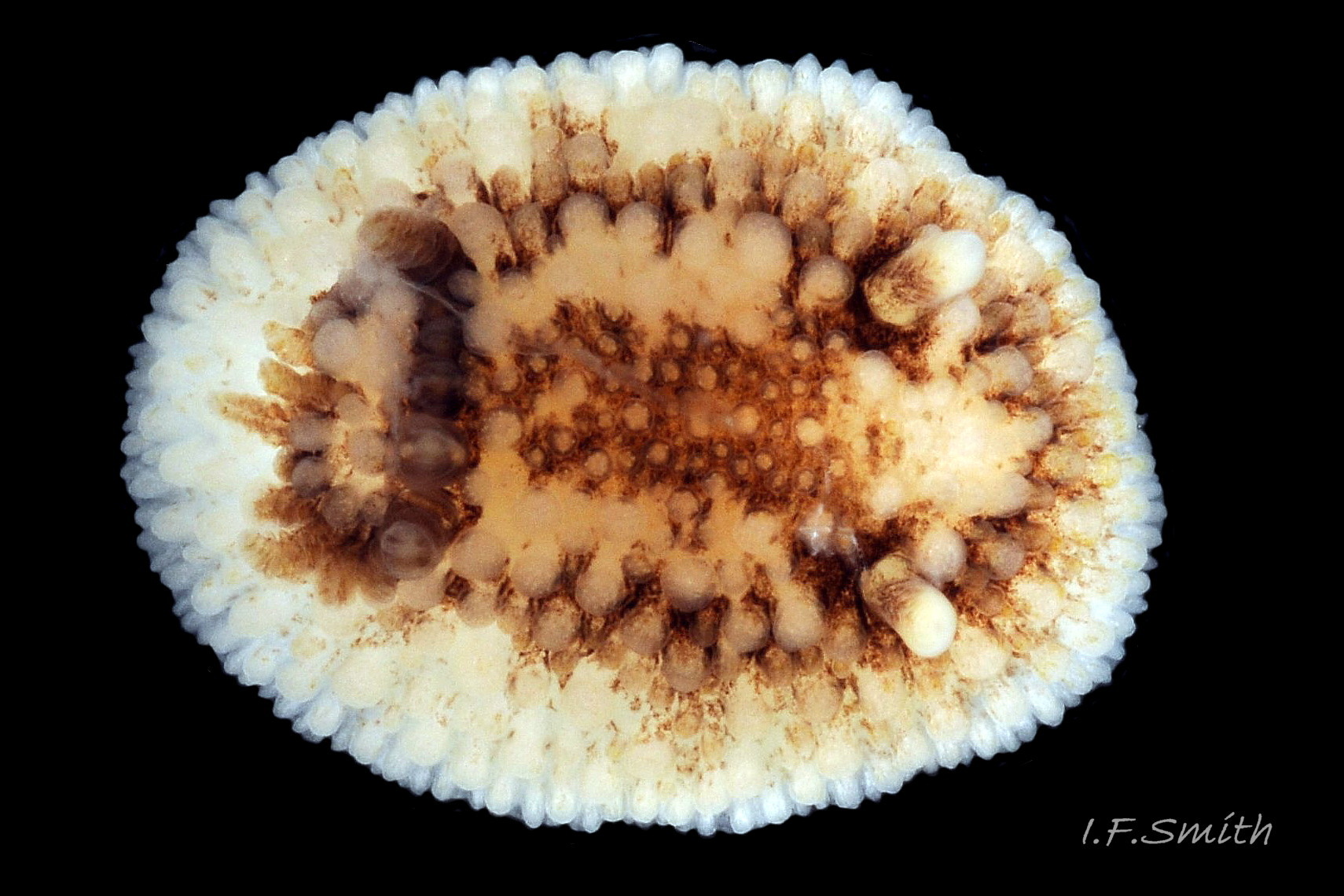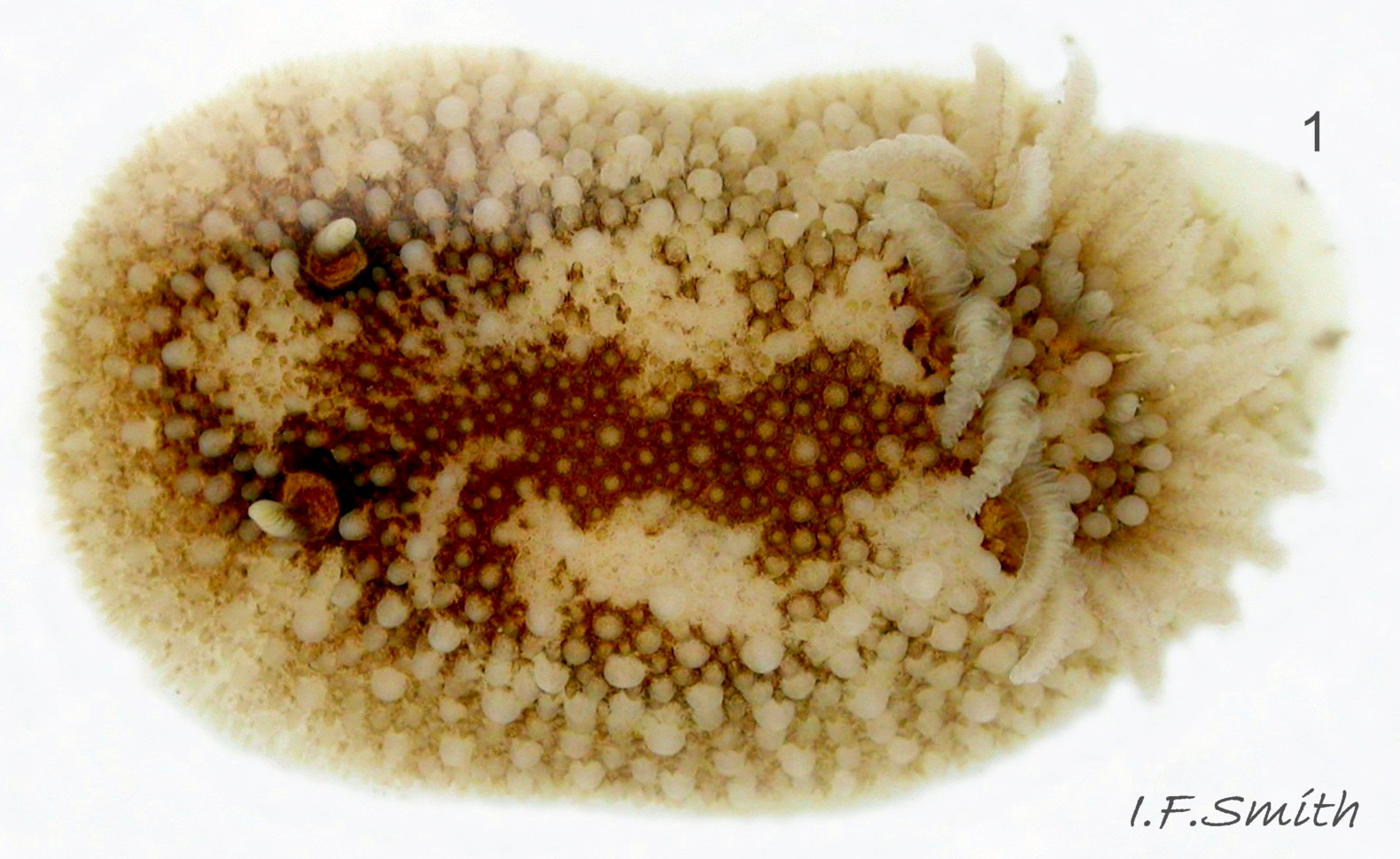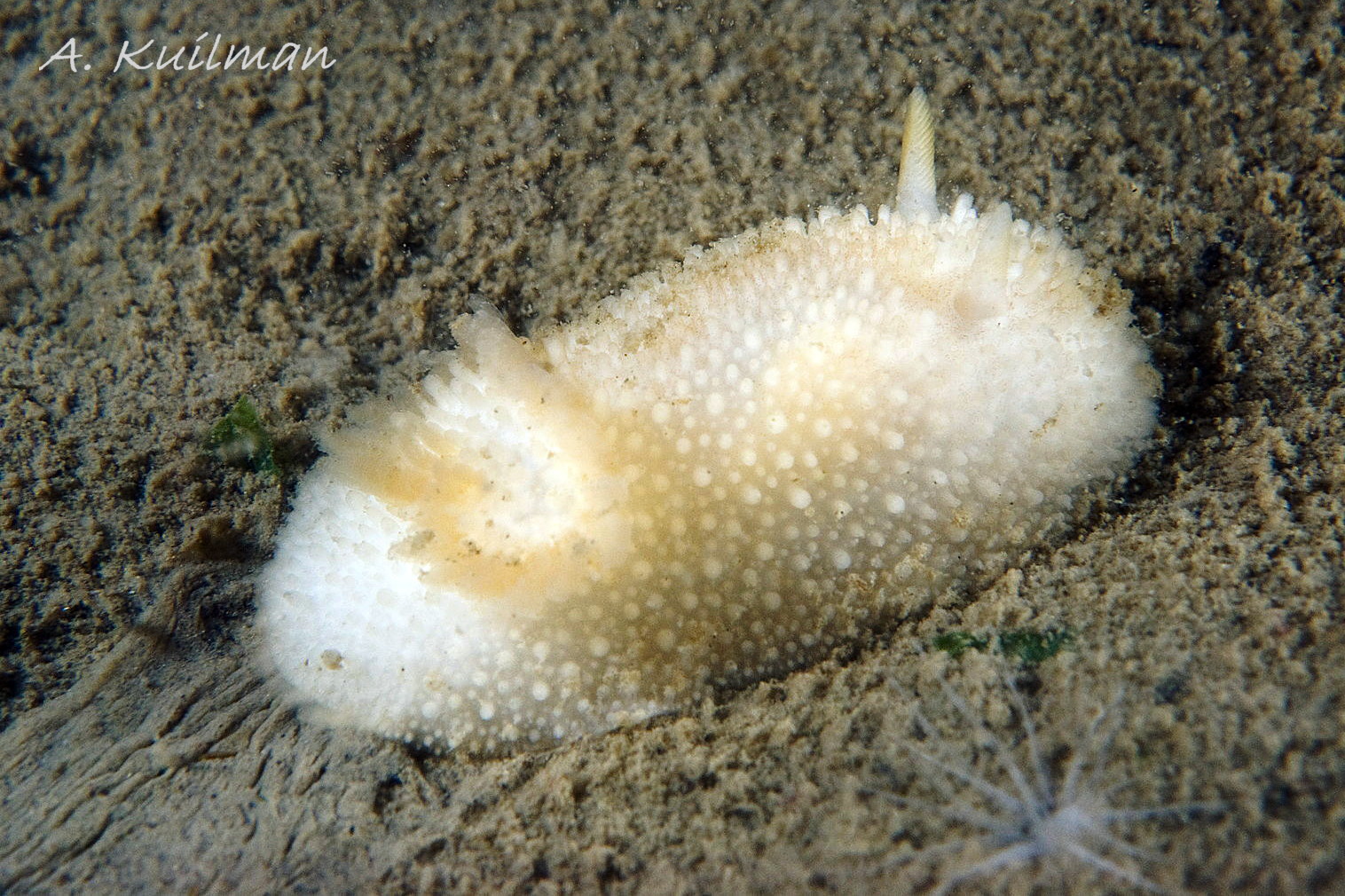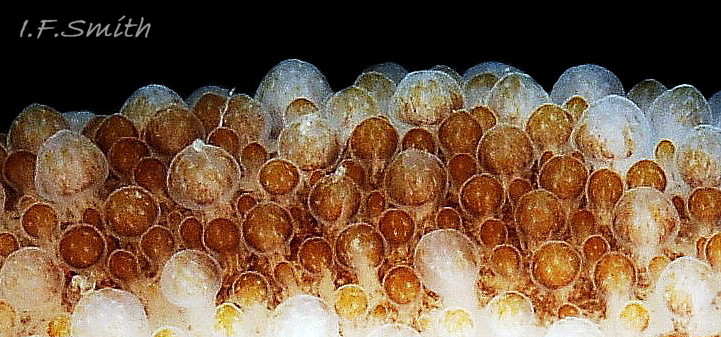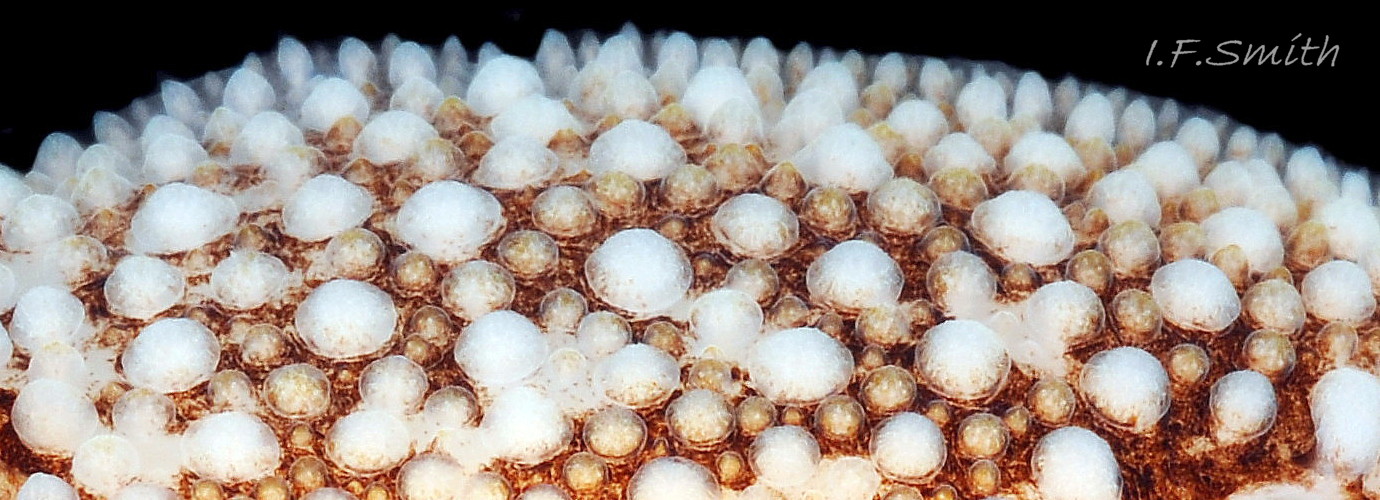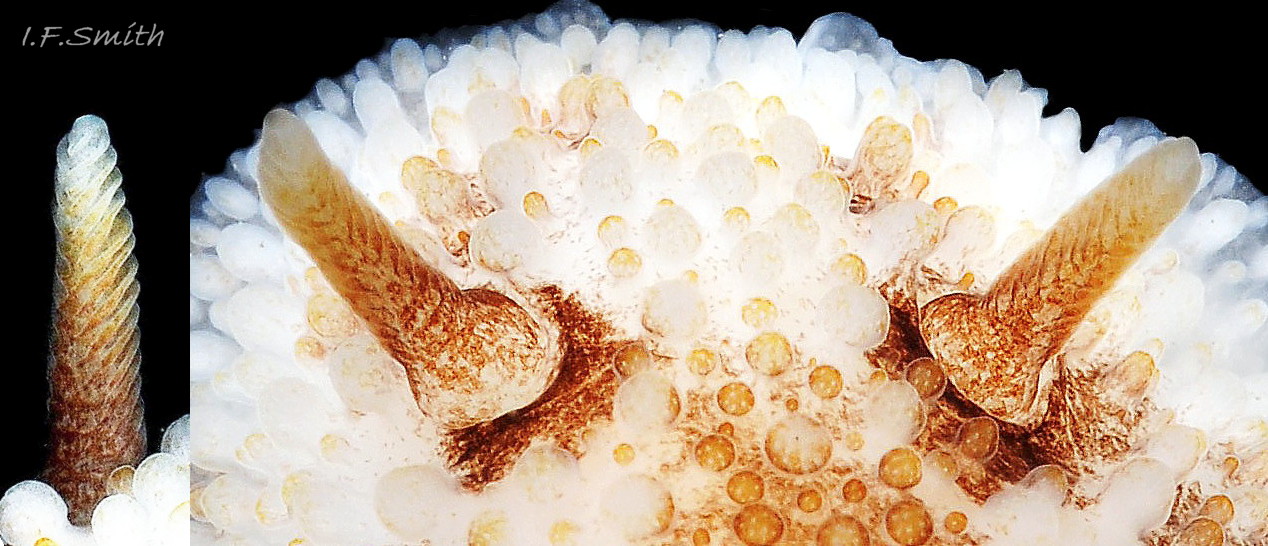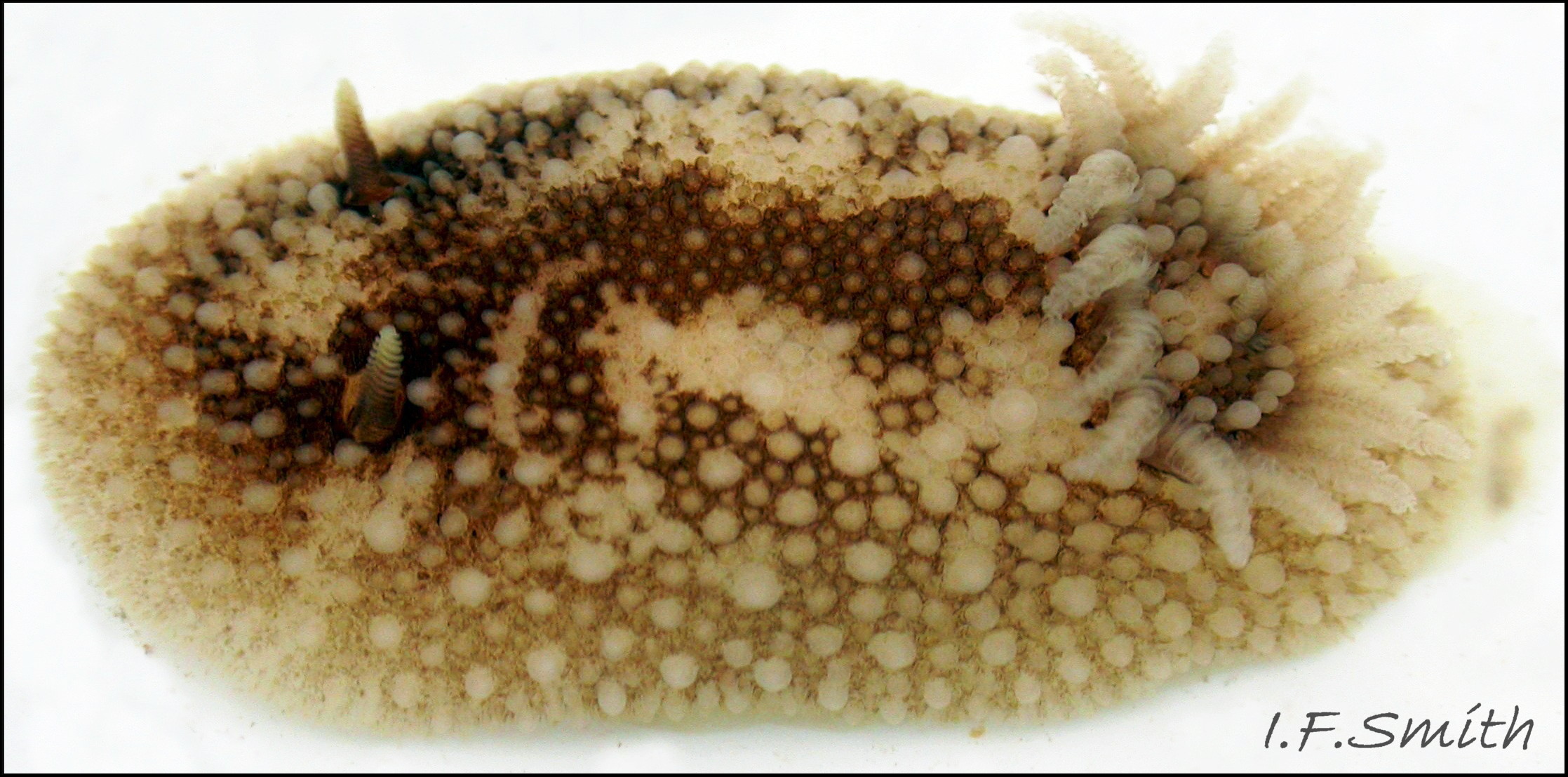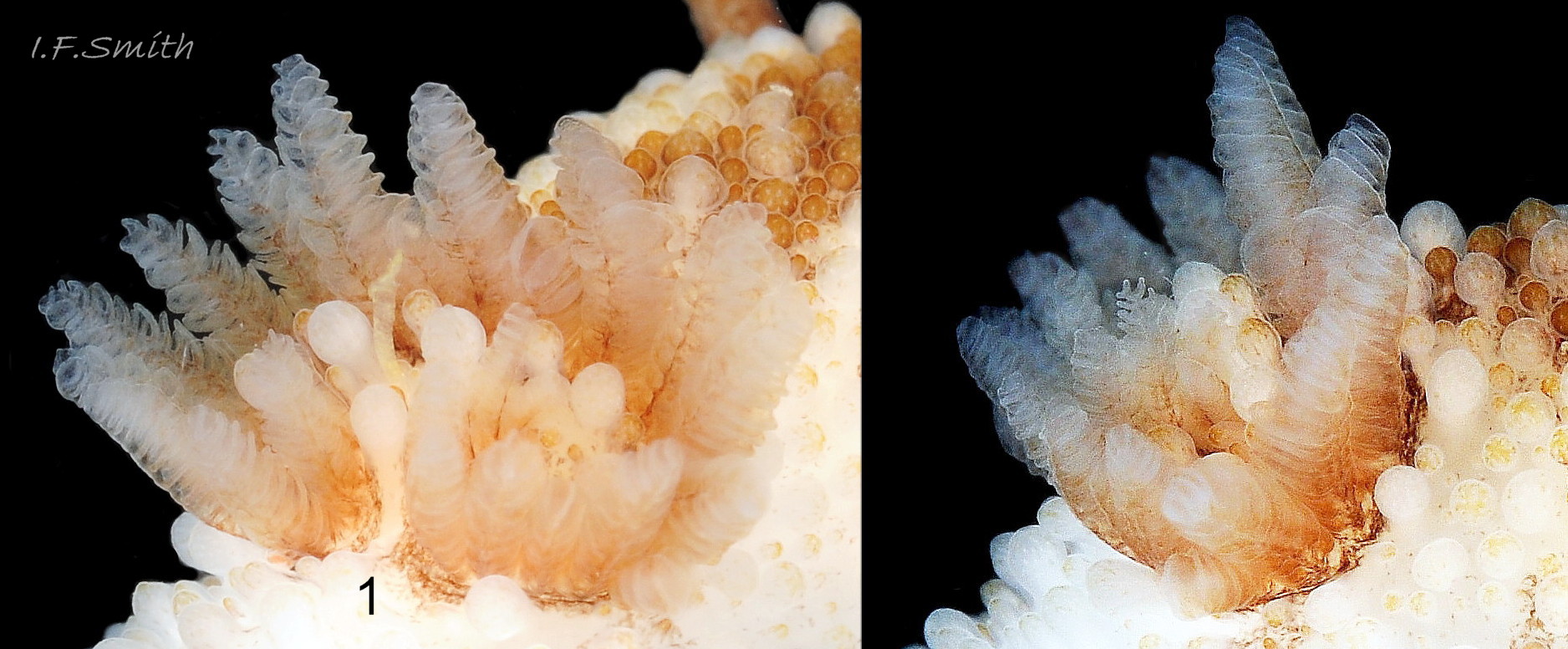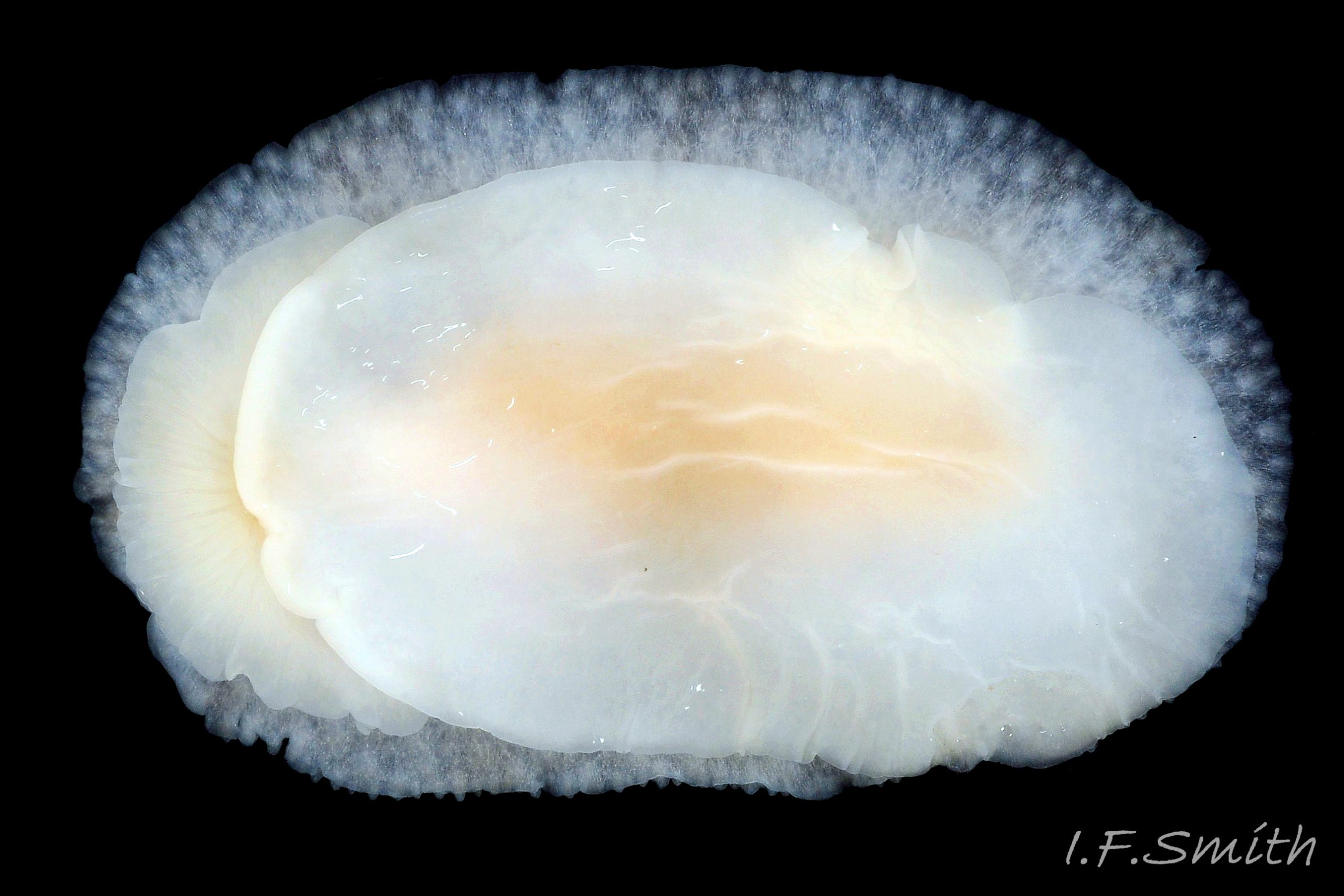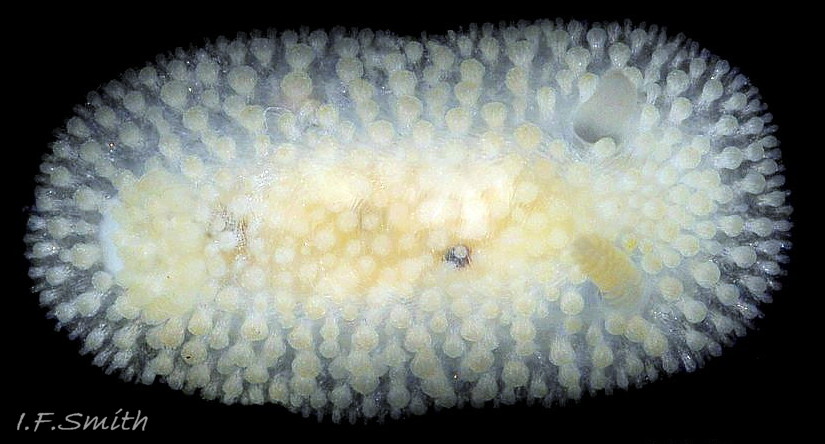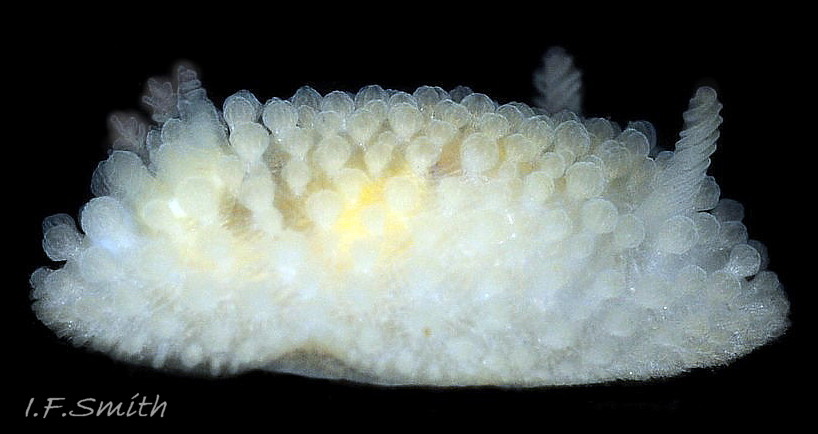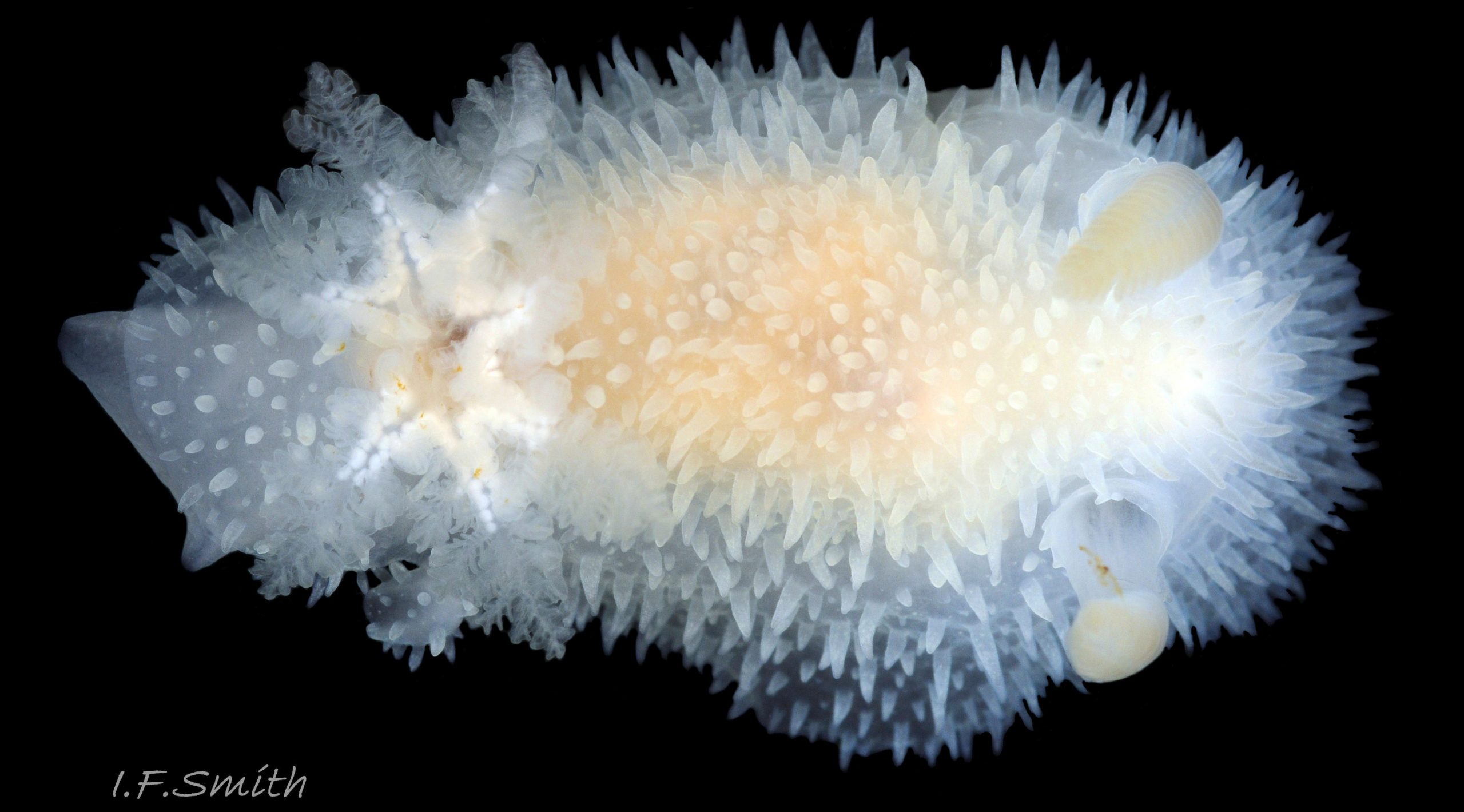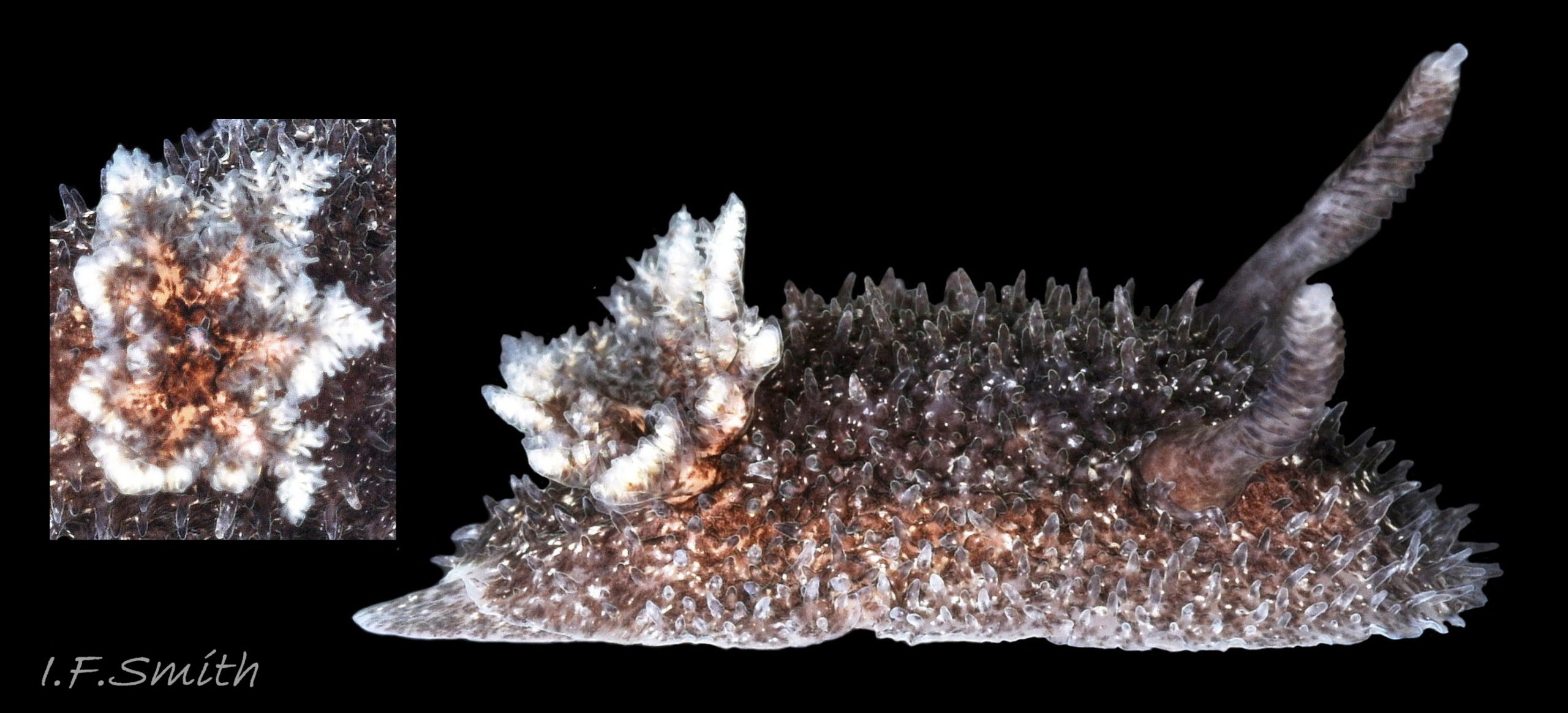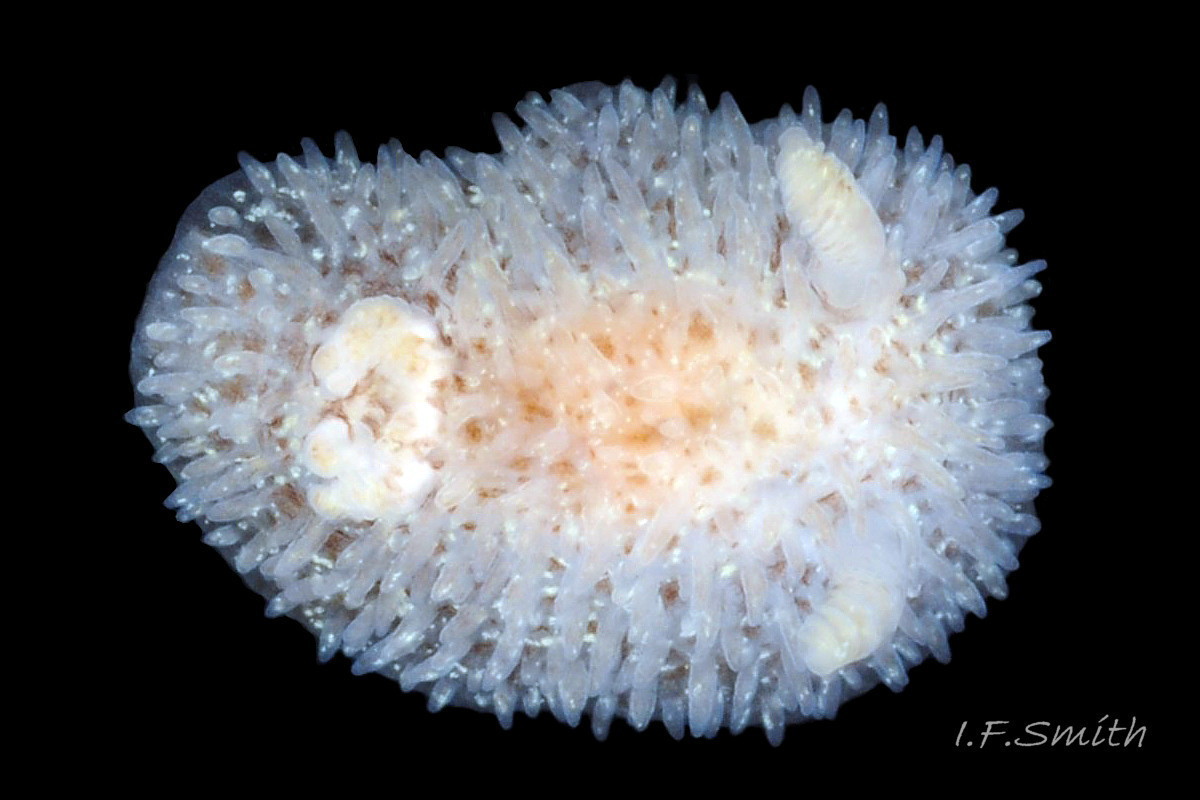Click image to enlarge with full caption. Main text below slider.
Onchidoris bilamellata (Linnaeus, 1767)
PDF available at www.researchgate.net/publication/358891355_Onchidoris_bil…
Current taxonomy: World Register of Marine Species
www.marinespecies.org/aphia.php?p=taxdetails&id=150457
Synonyms: Doris bilamellata Linnaeus, 1767; Onchidoris fusca (Müller O. F., 1776).
Meaning of name
Doris = a sea nymph, bilamellata = two lamellae (layers)
GLOSSARY BELOW
Description
O. bilamellata grows up to 40 mm long 06 Onchidoris bilamellata . Only a small part of the foot ever protrudes into view beyond the ample mantle in normal activity 06 Onchidoris bilamellata & 02 Onchidoris bilamellata . The ground colour of the flesh is dull white overlaid by varying amounts of brown pigment. Thompson and Brown (1984) states that juveniles “all pass through a pure white stage; brown pigment appears – – at about 2 mm”, but brown can be seen at smaller sizes 03 Onchidoris bilamellata . Brown is nearly always present on the gills, at the base of the rhinophores and as a dorsal panel between gills and rhinophores 04 Onchidoris bilamellata . Brown extends beyond the dorsal panel at varied sizes 05 Onchidoris bilamellata and reaches the periphery on some 01 Onchidoris bilamellata . The gills may become paler on the largest specimens 06 Onchidoris bilamellata . The occasional rare specimen remains completely white at all stages 07 Onchidoris bilamellata .
When extended, the mantle tubercles have an almost spherical head on a narrow stem 08 Onchidoris bilamellata , but when retracted they form rounded mounds 09 Onchidoris bilamellata . Those on the dorsal panel are smaller than those on the sides and those near the perimeter may be small and narrower. Frequently, but not always, the tubercles lack brown pigment and contrast white against the surrounding brown 09 Onchidoris bilamellata .
The almost linear rhinophores each have a small, truncated, pale apex above about fifteen lamellae which increase in intensity of brown down to the bulbous base recessed in a pit 10 Onchidoris bilamellata . The gills are arranged in a transverse slender ellipse, almost straight on its anterior, which extends over about 60% of the chiton’s width 01 Onchidoris bilamellata . There is a small gap in the posterior of the ellipse 12 Onchidoris bilamellata . Adults have up to twenty-nine unipinnate gills 11 Onchidoris bilamellata . The space within the ellipse is crowded with large tubercles and, often, about five additional small gills 12 Onchidoris bilamellata . Gills on juveniles are often dark brown 05 Onchidoris bilamellata and grow paler with age.
The head consists of a wide, curved, wavy edged, white oral veil, often with a slight yellow tint near the mouth 13 Onchidoris bilamellata and 14 Onchidoris bilamellata . There are no visible eyes.
The foot has a translucent white or yellowish white sole 13 Onchidoris bilamellata , showing yellowish or, according to Alder and Hancock (1845-55), purple viscera 14 Onchidoris bilamellata . The sole is an ellipse, smoothly rounded at both ends.
escription
O. bilamellata grows up to 40 mm long 06 Onchidoris bilamellata . Only a small part of the foot ever protrudes into view beyond the ample mantle in normal activity 06 Onchidoris bilamellata & 02 Onchidoris bilamellata . The ground colour of the flesh is dull white overlaid by varying amounts of brown pigment. Thompson and Brown (1984) states that juveniles “all pass through a pure white stage; brown pigment appears – – at about 2 mm”, but brown can be seen at smaller sizes 03 Onchidoris bilamellata . Brown is nearly always present on the gills, at the base of the rhinophores and as a dorsal panel between gills and rhinophores 04 Onchidoris bilamellata . Brown extends beyond the dorsal panel at varied sizes 05 Onchidoris bilamellata and reaches the periphery on some 01 Onchidoris bilamellata . The gills may become paler on the largest specimens 06 Onchidoris bilamellata . The occasional rare specimen remains completely white at all stages 07 Onchidoris bilamellata .
When extended, the mantle tubercles have an almost spherical head on a narrow stem 08 Onchidoris bilamellata , but when retracted they form rounded mounds 09 Onchidoris bilamellata . Those on the dorsal panel are smaller than those on the sides and those near the perimeter may be small and narrower. Frequently, but not always, the tubercles lack brown pigment and contrast white against the surrounding brown 09 Onchidoris bilamellata .
The almost linear rhinophores each have a small, truncated, pale apex above about fifteen lamellae which increase in intensity of brown down to the bulbous base recessed in a pit 10 Onchidoris bilamellata . The gills are arranged in a transverse slender ellipse, almost straight on its anterior, which extends over about 60% of the chiton’s width 01 Onchidoris bilamellata . There is a small gap in the posterior of the ellipse 12 Onchidoris bilamellata . Adults have up to twenty-nine unipinnate gills 11 Onchidoris bilamellata . The space within the ellipse is crowded with large tubercles and, often, about five additional small gills 12 Onchidoris bilamellata . Gills on juveniles are often dark brown 05 Onchidoris bilamellata and grow paler with age.
The head consists of a wide, curved, wavy edged, white oral veil, often with a slight yellow tint near the mouth 13 Onchidoris bilamellata and 14 Onchidoris bilamellata . There are no visible eyes.
The foot has a translucent white or yellowish white sole 13 Onchidoris bilamellata , showing yellowish or, according to Alder and Hancock (1845-55), purple viscera 14 Onchidoris bilamellata . The sole is an ellipse, smoothly rounded at both ends.
Description
O. bilamellata grows up to 40 mm long 06 Onchidoris bilamellata . Only a small part of the foot ever protrudes into view beyond the ample mantle in normal activity 06 Onchidoris bilamellata & 02 Onchidoris bilamellata . The ground colour of the flesh is dull white overlaid by varying amounts of brown pigment. Thompson and Brown (1984) states that juveniles “all pass through a pure white stage; brown pigment appears – – at about 2 mm”, but brown can be seen at smaller sizes 03 Onchidoris bilamellata . Brown is nearly always present on the gills, at the base of the rhinophores and as a dorsal panel between gills and rhinophores 04 Onchidoris bilamellata . Brown extends beyond the dorsal panel at varied sizes 05 Onchidoris bilamellata and reaches the periphery on some 01 Onchidoris bilamellata . The gills may become paler on the largest specimens 06 Onchidoris bilamellata . The occasional rare specimen remains completely white at all stages 07 Onchidoris bilamellata .
When extended, the mantle tubercles have an almost spherical head on a narrow stem 08 Onchidoris bilamellata , but when retracted they form rounded mounds 09 Onchidoris bilamellata . Those on the dorsal panel are smaller than those on the sides and those near the perimeter may be small and narrower. Frequently, but not always, the tubercles lack brown pigment and contrast white against the surrounding brown 09 Onchidoris bilamellata .
The almost linear rhinophores each have a small, truncated, pale apex above about fifteen lamellae which increase in intensity of brown down to the bulbous base recessed in a pit 10 Onchidoris bilamellata . The gills are arranged in a transverse slender ellipse, almost straight on its anterior, which extends over about 60% of the chiton’s width 01 Onchidoris bilamellata . There is a small gap in the posterior of the ellipse 12 Onchidoris bilamellata . Adults have up to twenty-nine unipinnate gills 11 Onchidoris bilamellata . The space within the ellipse is crowded with large tubercles and, often, about five additional small gills 12 Onchidoris bilamellata . Gills on juveniles are often dark brown 05 Onchidoris bilamellata and grow paler with age.
The head consists of a wide, curved, wavy edged, white oral veil, often with a slight yellow tint near the mouth 13 Onchidoris bilamellata and 14 Onchidoris bilamellata . There are no visible eyes.
The foot has a translucent white or yellowish white sole 13 Onchidoris bilamellata , showing yellowish or, according to Alder and Hancock (1845-55), purple viscera 14 Onchidoris bilamellata . The sole is an ellipse, smoothly rounded at both ends.
Key identification features
Onchidoris bilamellata
1) Dark brown dorsal panel 03 Onchidoris bilamellata & 04 Onchidoris bilamellata , rarely all white.
2) Gill ring is a large transverse slender ellipse across the body, anterior almost flat 01 Onchidoris bilamellata .
3) Large, frequently unpigmented tubercles with spherical or domed head 08 Onchidoris bilamellata & 09 Onchidoris bilamellata .
Similar species
Onchidoris muricata (O. F. Müller, 1776) 15 Onchidoris bilamellata & 16 Onchidoris bilamellata.
1) White mantle, max length 14 mm, sometimes confused with juvenile, rare all-white O. bilamellata.
2) Gill ring a small, unobtrusive circle.
3) Club-shape tubercles on mantle are more evenly sized than on O. bilamellata.
Acanthodoris pilosa (Abildgaard [in Müller], 1789) 17 Onchidoris bilamellata and 18 Onchidoris bilamellata .
1) White specimens sometimes confused with rare all-white O. bilamellata.
Brown specimens sometimes confused with O. bilamellata, but brown is evenly distributed, does not form a distinct dorsal panel.
2) Expanded tripinnate gills form a large rosette, often wider than body, with white pigment resembling a star. When contracted, gills form a small oval, open at posterior 19 Onchidoris bilamellata.
3) Soft, tall, thin, conical tubercles on mantle.
Habits and ecology
O. bilamellata lives on the lower shore and sublittoral fringe to about 20 m depth, where it feeds on the non-chitinous parts of barnacles, such as Semibalanus balanoides and Elminius modestus. Numerous observations suggest migrations for breeding or feeding, but the causes are difficult to verify. Whatever the impetus, mass movements with hundreds following in each other’s tracks occur and have been photographed 20 Onchidoris bilamellata . Each lays a track of slime as it travels 07 Onchidoris bilamellata so presumably the slime trails of others ease travel. This behaviour occurs with some other species such as Haminoea navicula. Like other nudibranchs it is a simultaneous hermaphrodite, but unlike most, it does not breed until it reaches full size. It spawns twice in a lifetime of 12 to 16 months Miller (1962). Spawning in Britain occurs in all months of the year, with a maximum in February and a secondary peak in some years in August (Alder & Hancock, 1845 – 55). Spawn masses, resembling everted, high, white collars 21 Onchidoris bilamellata , are often deposited on barnacle rich shores in large obvious amounts by hundreds of congregated adults. Planktonic veliger larvae hatch from the spawn and live in the plankton before transforming into adult form.
Distribution and status
O. bilamellata is recorded from the Arctic to Galicia, Spain, and from Atlantic and Pacific coasts of North America. GBIF map www.gbif.org/species/5190124 . It is common and widespread round Britain and Ireland. UK map, NBN species.nbnatlas.org/species/NBNSYS0000176827
Acknowledgements
I am most grateful for the use of images by Jim Anderson and Arne Kuilman.
References and links
Alder, J. & Hancock, A. 1845-1855. A monograph of the British nudibranchiate mollusca. London, Ray Society.
Miller, M.C. (1962) Annual cycles of some Manx nudibranchs, with a discussion of the problem of migration. J. Anim. Ecol., 31 : 545-569.
Thompson, T.E. & Brown, G.H. 1984. Biology of opisthobranch molluscs 2. London,
Current taxonomy: World Register of Marine Species
www.marinespecies.org/aphia.php?p=taxdetails&id=150457
Glossary
hermaphrodite, simultaneous = individual acts as both male and female at the same time with similar partner(s).
lamellae = (of sea slugs) small plates on rhinophores or leaflets of gill.
mantle = (of nudibranchs) sheet of tissue forming part or all of notum (dorsal body surface).
oral veil = anterior extension of head into a flat sheet.
rhinophore = chemo-receptor tentacle; many sea slugs have a pair on top of the head.
tripinnate = (of gill plume) threefold branching; “trunk, boughs, branches”.
unipinnate = (of gill plume) branching singly; boughs but no subsequent branches or twigs, in one plane like a feather.
veliger = shelled larva of marine gastropod or bivalve mollusc which moves by action of cilia on a velum (bilobed flap). Stage may be passed in plankton or within liquid-filled egg-capsule.
